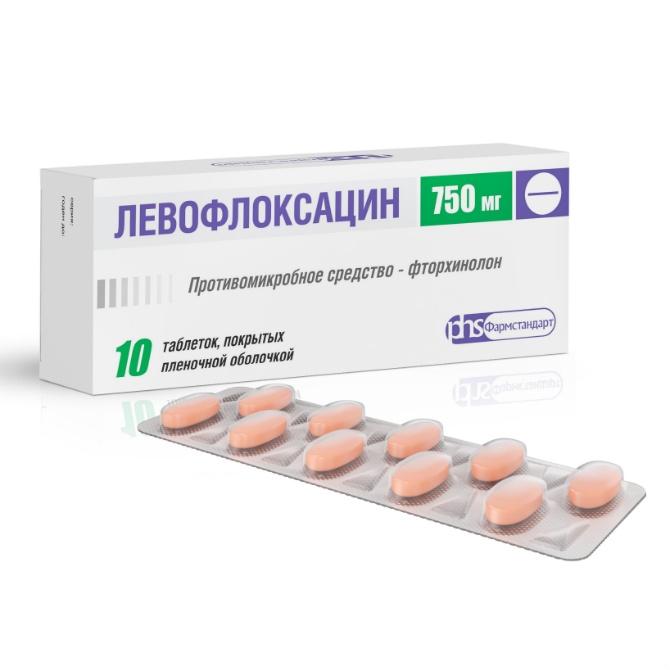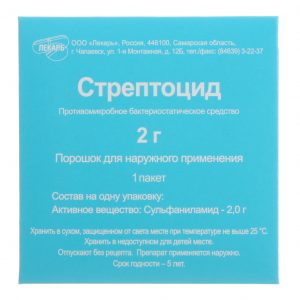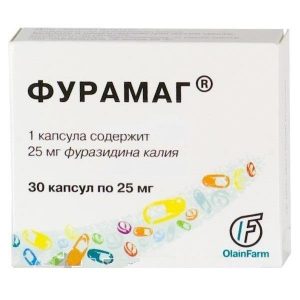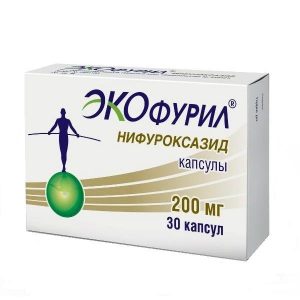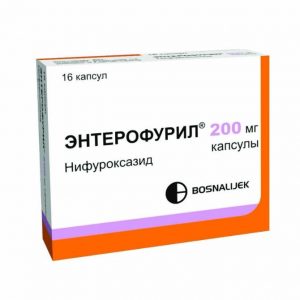Description
Indications
Levofloxacin in the form of tablets and an infusion solution is prescribed in the treatment of the following infectious and inflammatory diseases caused by microorganisms sensitive to the action of its active substance: Acute sinusitis (tablets) Exacerbation of chronic bronchitis (tablets) Soft tissue and skin infections (tablets) Bacterial prostatitis Community-acquired pneumonia Uncomplicated and complicated urinary tract infections, including pyelonephritis Bacteriemia / septicemia associated with the above indications Intraabdominal tuberculosis infections infusion solution, simultaneously with other drugs).
Contraindications
Age up to 1 year (eye drops), up to 18 years (tablets and infusion solution) Pregnancy and lactation Hypersensitivity to the drug or other quinolones. Additional contraindications to the use of Levofloxacin in the form of tablets and an infusion solution are: Tendon lesions with previous treatment with quinolones. Epilepsy. Renal failure with creatinine clearance less than 20 ml per minute (tablets). Long Q-T interval (infusion solution). Concurrent use with class I antiarrhythmic drugs (quinidine, procainamide) or class III (amiodarone, sotalol) (infusion solution).
Use during pregnancy and lactation
Contraindicated in pregnancy and lactation.
Special instructions
In severe pneumonia caused by pneumococci, levofloxacin may not produce the optimal therapeutic effect. Hospital infections caused by certain pathogens (P. aeruginosa), may require combination treatment. During treatment with Levofloxacin, it is possible to develop an attack of seizures in patients with a previous brain damage caused, for example, by a stroke or severe trauma. Despite the fact that photosensitization is very rare with levofloxacin, in order to avoid it, patients are not recommended to undergo strong sunlight or artificial ultraviolet radiation without special need. If pseudomembranous colitis is suspected, levofloxacin should be immediately withdrawn and appropriate treatment should be initiated. In such cases, drugs that inhibit intestinal motility should not be used. The use of alcohol and alcoholic beverages in the treatment of Levofloxacin is prohibited. Rarely observed with the use of the drug Levofloxacin tendonitis (primarily inflammation of the Achilles tendon) can lead to rupture of tendons. Elderly patients are more prone to tendonitis. Treatment with glucocorticosteroids in all likelihood increases the risk of tendon rupture. If you suspect a tendonitis, you should immediately stop treatment with Levofloxacin and begin appropriate treatment of the affected tendon. Patients with glucose-6-phosphate dehydrogenase deficiency (a hereditary metabolic disorder) can respond to fluoroquinolones by destroying red blood cells (hemolysis). In this regard, the treatment of such patients with levofloxacin should be carried out with great care.
Composition
Levofloxacin – 500 mg (levofloxacin hemihydrate – 256.23 or 512.46 mg) Auxiliary components (tablets of 250 or 500 mg, respectively): microcrystalline cellulose – 30.83 / 61.66 mg, hypromellose – 8.99 / 17.98 mg, croscarmellose sodium – 9.3 / 18.6 mg, polysorbate 80 – 1.55 / 3.1 mg, calcium stearate – 3.1 / 6.2 mg.
Shell composition (tablets of 250 or 500 mg, respectively): hypromellose – 7.5 / 15 mg, hydroxypropyl cellulose (hyprolose) – 2.91 / 5.82 mg, talc – 2.89 / 5.78 mg, titanium dioxide – 1.63 / 3.26 mg, yellow iron oxide (yellow oxide) – 0.07 / 0, 14 mg or a dry mixture for film coating (hypromellose 50%, hyprolose (hydroxypropyl cellulose) – 19.4%, talc – 19.26%, titanium dioxide – 10.87%, yellow iron oxide (yellow oxide) – 0.47% ) – 15/30 mg.
Dosage and administration
Inside, during meals, or between meals, without chewing, with plenty of fluids. Doses are determined by the nature and severity of the infection, as well as the sensitivity of the suspected pathogen. Recommended dose for adults with normal renal function (CC> 50 ml / min): In acute sinusitis – 500 mg 1 time per day for 10-14 days. With exacerbation of chronic bronchitis – 250 to 500 mg 1 time per day for 7-10 days. In community-acquired pneumonia – 500 mg 1 or 2 times a day for 7-14 days For uncomplicated infections of the urinary tract and kidneys – 250 mg 1 time per day for 3 days For complicated infections of the urinary tract and kidneys – 250 mg 1 time per day for 7-10 days With bacterial prostatitis – 500 mg 1 time a day for 28 days For infections of the skin and soft tissues – 250 mg – 500 mg 1 or 2 times a day for 7-14 days Intraabdom -functional infection – 250 mg 2 times daily or 500 mg once a day 1 – 7-14 days (in combination with antibacterial agents acting on the anaerobic flora). Tuberculosis – inside of 500 mg 1-2 times a day for up to 3 months. In case of impaired liver function, a special selection of doses is not required, since levofloxacin is only slightly metabolized in the liver and excreted mainly by the kidneys. If you have missed taking the drug, you need to take the pill as soon as possible until the time for the next dose is near. Next, continue to take levofloxacin according to the scheme. The duration of therapy depends on the type of disease. In all cases, treatment should be continued from 48 to 72 hours after the disappearance of the symptoms of the disease
Side effects
itching and redness of the skin are general hypersensitivity reactions (anaphylactic and anaphylactoid reactions) with symptoms such as urticaria, narrowing of the bronchi and possibly severe suffocation swelling of the skin and mucous membranes (for example, in the face and pharyngeal pressure) sudden drop and shock hypersensitivity to solar and ultraviolet radiation allergic pneumonitis vasculitis toxic epidermal necrolysis (Lyell’s syndrome) exudative erythema multiforme nausea, vomiting ot diarrhea, loss of appetite for abdominal pain, pseudomembranous colitis, a decrease in blood glucose concentration, which is of particular importance for patients with diabetes mellitus (possible signs of hypoglycemia: increased appetite, nervousness, perspiration, trembling) exacerbation of porphyria in patients, already suffering from this disease headache dizziness and / or numbness drowsiness sleep disturbances anxiety tremors psychotic reactions such as hallucinations and depressions seizures mental confusion visual impairment and hearing impairment taste and smell decrease tactile sensitivity increased heartbeat joint and muscle pain tendon rupture (for example, achilles a) deterioration of renal function up to acute renal failure interstitial nephritis increase in the number of eosinophils menshenie number of white blood cells neutropenia, thrombocytopenia, which may be accompanied by increased bleeding agranulocytosis pancytopenia fever.
Drug Interactions
There are reports of a marked decrease in the seizure threshold while using quinolones and substances that, in turn, can lower the cerebral seizure threshold. This applies equally to the simultaneous use of quinolones and theophylline. The effect of the drug Levofloxacin is significantly weakened with simultaneous use with sucralfate. The same thing happens with the simultaneous use of magnesium- or aluminum-containing antacids, as well as iron salts. Levofloxacin should be taken at least 2 hours before or 2 hours after taking these funds. No interaction with calcium carbonate was detected. With the simultaneous use of vitamin K antagonists, control of the blood coagulation system is necessary. Excretion (renal clearance) of levofloxacin slightly slows down under the action of cimetidine and probenicide. It should be noted that this interaction has practically no clinical significance. However, with the simultaneous use of drugs such as probenicide and cimetidine, which block a specific excretion route (tubular secretion), treatment with levofloxacin should be carried out with caution. This applies primarily to patients with limited renal function. Levofloxacin slightly increases the half-life of cyclosporine. Taking glucocorticosteroids increases the risk of tendon rupture.
Storage conditions
List B. Keep out of the reach of children, dry and protected from light, at a temperature not exceeding 25 ° C.
Expiration
2 years
Dosage form
tablets
Appointment
Children by appointment doctor’s appointment
Indications
furunkulov Here, Here sinusitis, From infectious diseases, From sinusitis, From respiratory tract infections, From prostatitis, Bronchitis, From tuberculosis, From skin infections, From urinary tract infections, From inflammation of female genital organs, From pneumonia
Pharmstandard-Tomsk, Russia
